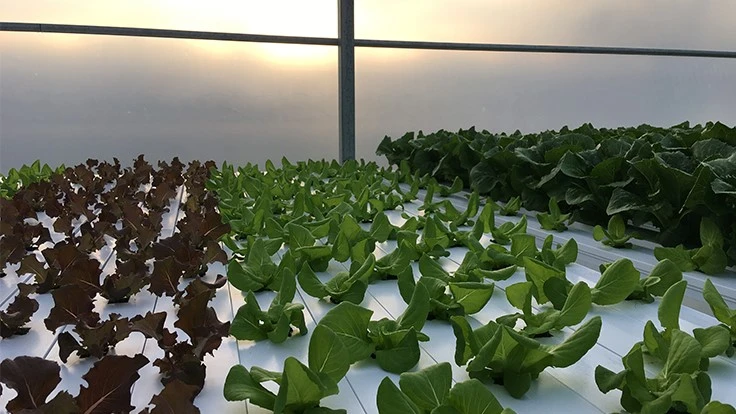
CropKing recommends using a nutrient film technique (NFT) system for lettuce and leafy greens production. In this type of system, a thin film of nutrient solution flows through the channels and over the roots, which provides constant access to both nutrient rich water and oxygen for the roots, said horticulturist Jim Brown.
Growers want to keep lettuce and leafy greens in the vegetative growth phase, as opposed to the reproductive growth phase, which tomatoes, cucumbers and peppers should be in, Brown said. Ideally, lettuce should not experience too long days or high temperatures, or it can enter the reproductive phase where its stem elongates and the plant bolts. During the day, growers should keep the lettuce environment between 65 to 75 degrees Fahrenheit and never below 60 degrees Fahrenheit at night.
Although there are other options for experienced growers, CropKing recommends using rockwool for seeding lettuce and leafy greens because it is “fool-proof,” Brown said. Growers can germinate either raw or pelletized, clay-coated seed, in the 68 to 70-degree range.
Different lettuce crop varieties can be in the greenhouse — both pre and post-transplant — for 90 days or fewer, and many for 60 days or fewer, Brown said. Bibb, the lettuce CropKing recommends many of its growers start with, takes between 14 and 21 days before transplant and then approximately 35-42 days to harvest in the winter. In the summer, it takes between 7 and 14 days to transplant and approximately 28-32 days to harvest. The actual timeframes are dependent on the size of finished head the grower is trying to achieve. These estimates are based on a 6 to 8-ounce finished head.
Growers should harvest their lettuce early in the morning or in the evening, Brown said. “You can reduce the shelf life by seven [to] three days if not harvesting it at the right time,” he said. “The lower the temperature, the better, in harvesting.”
When harvesting, growers should place their lettuce into a cooler within 15 to 20 minutes of the time it comes out of the channel, Brown said. They should store basil above 55 degrees Fahrenheit and lettuce and leafy greens between 38 to 42 degrees Fahrenheit. “Don't wait until you have a whole load to go to the cooler,” he said. “Get a box or two, get it into the cooler. That will greatly increase the shelf life and the quality of the product. Once you get it cool, keep it cool.”
Latest from Greenhouse Management
- 2025 Proven Winners Horticulture Scholarship applications now open
- How to improve inventory and shipping management in the greenhouse
- Leading Women of Horticulture: Anna Ball, Ball Hort, and Terri McEnaney, Bailey Nurseries
- GM CEA HERB Part 2: A guide to increasing the sowing density of culinary herbs
- GM CEA HERB Part 1: Best practices for producing culinary herbs in controlled environments
- USDA fires experts on invasive pests, including Asian citrus psyllid, chilli thrips
- CEA Alliance celebrates bipartisan introduction of Supporting Innovation in Agriculture Act
- Dümmen Orange North America celebrating 25th anniversary in 2025





